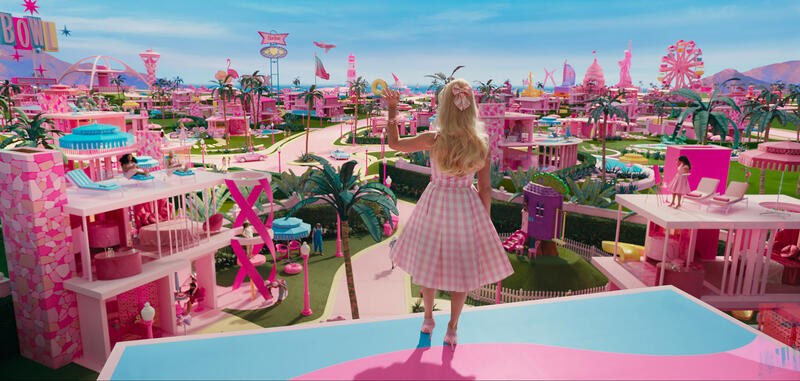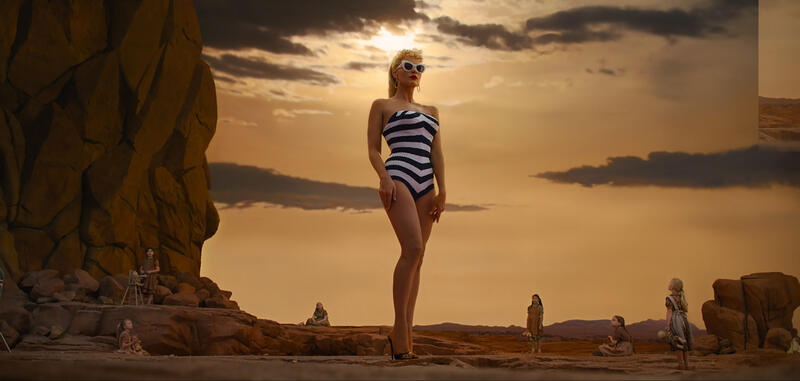How Greta Gerwig makes Mattel’s controversial doll lovable and hip
For weeks now, we’ve been bombarded with candy-colored giant posters, flashy movie trailers and TikTok videos, breathless press reports and shop window displays in hot pink. Barbie is set to be this summer’s blockbuster, and Warner Bros. and toy giant Mattel, the producers of this seemingly impossible film project, are leaving no doubt about that. After all, let’s be honest: Who is waiting for a movie about an aging stick figure doll in high heels? An uncool girl toy with a dubious reputation: sexist, anorexic, anti-emancipatory, hetero-normative, stupid and blonde. And who, by all means, wants to direct it?
Greta Gerwig! What was initially thought to be an April Fool’s joke is probably the biggest coup of the producers. They’ve tapped the it-girl of the New York indie scene to direct the Barbie movie. Gerwig is known for playful, feminist-leaning auteur films like Lady Bird and Little Women, plus she’s married to filmmaker Noah Baumbach (Marriage Story, White Noise), with whom she also wrote the film’s screenplay. That’s the second surprise: the two apparently weren’t intimidated by the enormous corporate pressure on the $145 million project, but pushed through their crazy, over-the-top idea. And in this story, Barbie’s image problem is the pink-hot core of the whole story.

Even the beginning is daring. In the opening sequence of the film, we see a group of girls in the desert playing with old-fashioned baby dolls. Their clothes are poor, their expressions joyless. Then, to the sound of „Also sprach Zarathustra“ a gigantic Barbie doll floats out of the sky, with silky blonde hair, red lips, a black and white bathing suit, and endlessly long legs. The original Barbie! The girls are intoxicated by the divine idol and smash their old dolls in slow motion. Unmistakably a parody of Kubrick’s famous Dawn of Man scene in 2001: A Space Odyssey. You can’t really set the bar any higher. And it’s hard to start a film about Barbie dolls more outrageously.
Who is waiting for film about an aging doll in high heels?
The actual story then leads into „Barbie Land,“ a pink plastic world in which humanized Barbie dolls live out their dream existence: Brushing hair, changing outfits, driving around in the Barbie convertible, waving at other Barbies, watching Ken surf or play volleyball at the beach, and having pajama parties at the Dreamhouse in the evenings. In Barbie Land, there exists more than equality. Every position there, from garbage collector to astronaut to Supreme Court judge, is held by women. Even the pink White House is run by a Black Barbie. The Kens, on the other hand, have to be content with their role of handsome but powerless boyfriends.
In the lavishly designed retro set with meticulously recreated Barbie houses, hand-painted sky and Billie Eilish sounds, the performers in their Barbie outfits play doll-like perfection. Until cracks open up in the plastic paradise. „Stereotypical Barbie“ (Margot Robbie) talks about dying – a taboo in Barbie Land. After all, Barbies don’t age. Suddenly, however, her eternal high-heeled feet go flat and the first signs of cellulite appear on her thigh. To reverse these shocking malfunctions, Barbie must travel to the „Real World,“ to the real people who invented her 64 years ago, then loved her for a long time, and now apparently dumped her. Gerwig stages the scenes from a naively imaginative perspective. The living Barbies float from the house to the beach as if moved by children’s hands, drink from empty cups, jump into paper waves. Getting to another world doesn’t require complex science fiction logic either, just roller skates and some imagination.




Barbie’s image problems are the pink-hot core of the story
The Real World in this case is Los Angeles. There, Barbie and her sidekick Ken (Ryan Gosling) walk through Venice Beach wearing stretch tops and neon skates, wondering why real people are staring at them funny. Barbie gets hit on by construction workers, Ken gets ogled by gays. Even teenagers who should be Barbie fans react allergically. She is a terrible, anti-feminist distorted image and is to blame for girls hating their bodies, one scolds. There is also a rude awakening at Mattel headquarters. Barbie, who until then believed her world, where women are in charge, was modeled after the Real World, finds that in reality only men sit in the executive chairs. They don’t want to know about Barbie’s problems, they just want to get her out of circulation as quickly as possible.
There are slapstick chase scenes and an esoteric encounter with Ruth Handler, the Mattel founder and Barbie inventor, who lives as a ghost on the 17th floor of the company headquarters. And finally, it comes to the big showdown in Barbie Land. There, Ken, enthralled by the patriarchal structures in the Real World, has seized power. How Barbie cunningly takes the reins from him again is so absurd and over-the-top staged that Gerwig deserves an Oscar for that alone. It ends in a riding battle with hobbyhorses and a cult-like, minimalistically funny musical choreography.




Ryan Gosling with his deeply tanned six-pack is the unofficial star of the film
Watch out for Ken! Here, too, the film scratches at the official Mattel narrative. In the Barbie cosmos, Ken is actually a minor character, the impotent fashion doll about whom lewd jokes are made. Gerwig, on the other hand, makes him the film’s unofficial star. And Ryan Gosling, with highlights, headband and deeply tanned six-pack, plays the ambivalent Barbie man with such relish and comedy as if there were no better role.
But despite all the subversive vignettes, the over-the-top musical numbers and feminist feel-good moments, the Barbie movie leaves you with mixed feelings. Perhaps because behind all the brilliant ideas, the product placement also flashes up: Barbie has to wear Birkenstock sandals because of her flat feet, and Birkenstocks can immediately be seen in close-up. Barbie dresses up for Ken, thanks to Chanel. The matching logo is emblazoned on heart-shaped purses, jewelry and the pink mini dress. Whether you like it or not, as a moviegoer you end up being part of a huge franchise. There’s a lot more than just Barbie dolls to be sold here. Mattel, the second largest toy company in the world, has announced that the film is just the beginning. The company wants to move away from its toy manufacturer image and become an intellectual property manager. Barbie as the new superhero with endless marketing potential. That’s a rather creepy idea, then. Greta Gerwig taught the plastic doll to walk and think, but she didn’t let Barbie Land burst into flames.
